The charm appears by color fades
This is a documentary film in which Mr. Yutaka Fujihara, a director of Harajuku’s vintage shop BerBerJin, lavishly explains the vintage denim and the artistically finished reproduction denim he offered.
Mr. Fujihara is known as one of Japan’s leading vintage denim masters and is involved in producing denim for various brands. His book “Denim as Education’” published by KADOKAWA and the daily updated “BerBerJin Channel” on YouTube are also contributing to the popularity of denim.
The Bikan Historical Quarter of Kurashiki City in Okayama where he visited has been designated as a Nationally Important Preservation District for traditional buildings, and the “old and new landscape” with both Japanese-style and Western-style architectures is rare in Japan.
At the Kurashiki Bikan Historical Quarter “Kojima Torajiro Memorial Museum”, which is the setting for SETO INLAND LINK, you can experience the charm of denim, which shines even more as it fades.
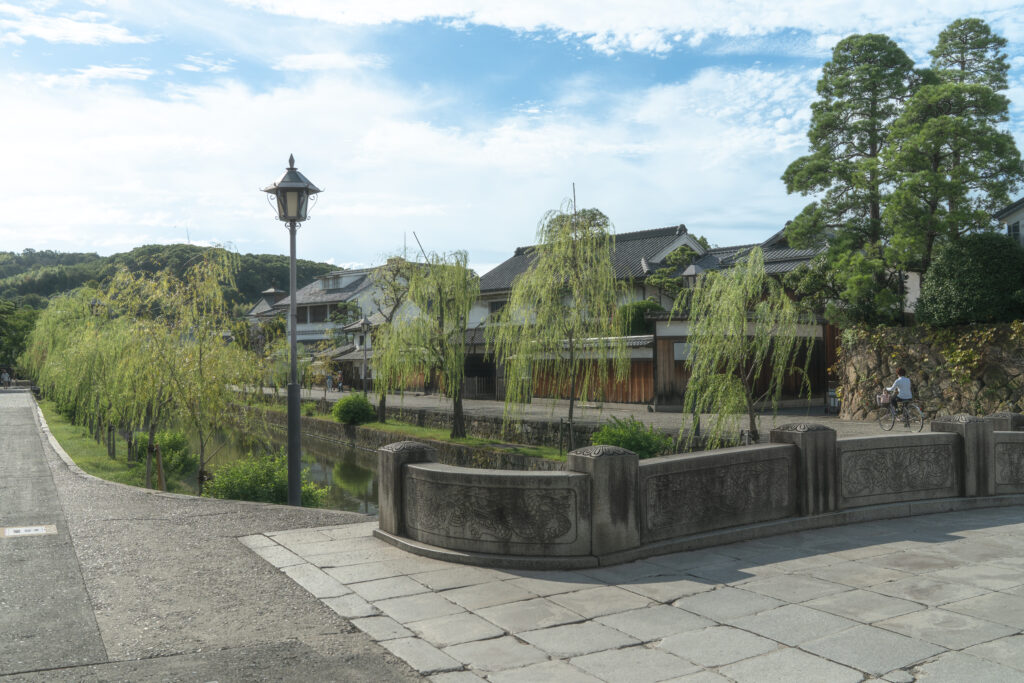
“Vintage feel of the town” unique to the Kurashiki Bikan Historical Quarter
The Kurashiki Bikan Historical Quarter is a unique place in Japan, with its mix of old-fashioned streetscapes, pure Japanese architecture, and retro-modern Western architecture.
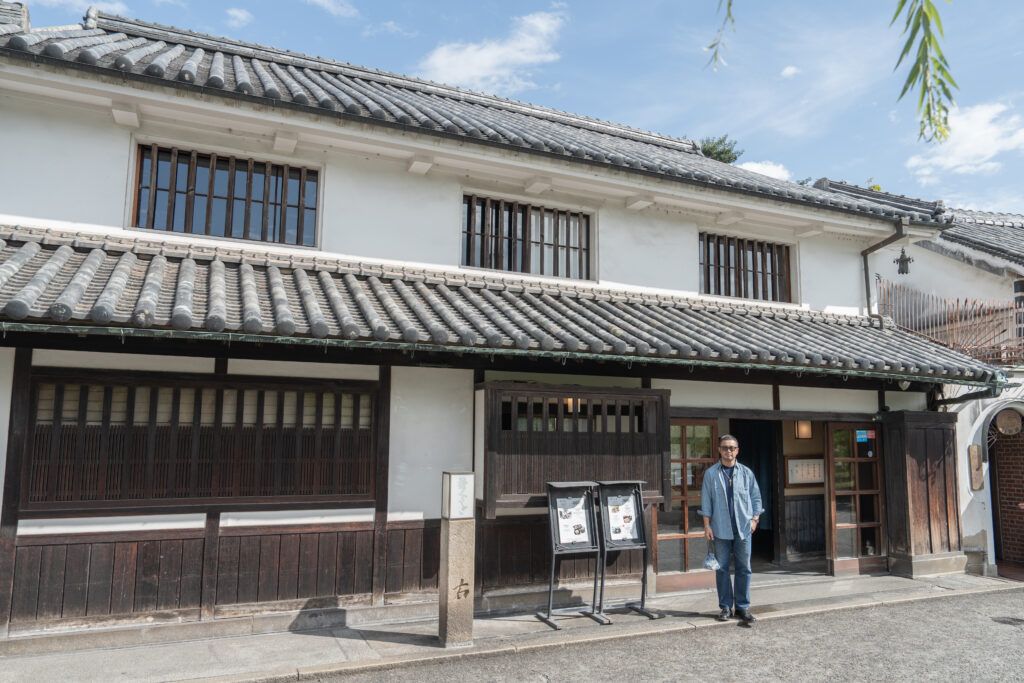
Speaking of pure Japanese architecture in the Kurashiki Bikan Historical Quarter, it is “Ryokan Kurashiki” which has a long history.
When I stayed there previously, I felt that the old-fashioned structure and calm atmosphere, which is not found in Tokyo, was “unique to the Kurashiki Bikan Historical Quarter.” The meal was very delicious and it was a wonderful place where I would like to stay again.

“Exhibition of vintage denim and reproduced denim” at Kojima Torajiro Memorial Museum
At the Kojima Torajiro Memorial Museum with Western-style architecture, there is an exhibition of vintage denim and reproduced denim, which is a major highlight of SETO INLAND LINK.
I am the director of the Harajuku shop “BerBerJin” and my life’s work involves working with a wide variety of denim.
Through SETO INLAND LINK, I have been visiting Okayama more and more and it makes me very happy.
And this time, my personal belongings are also on display. Let’s take a look.
Levis 501XX /Buckle Back 1942s
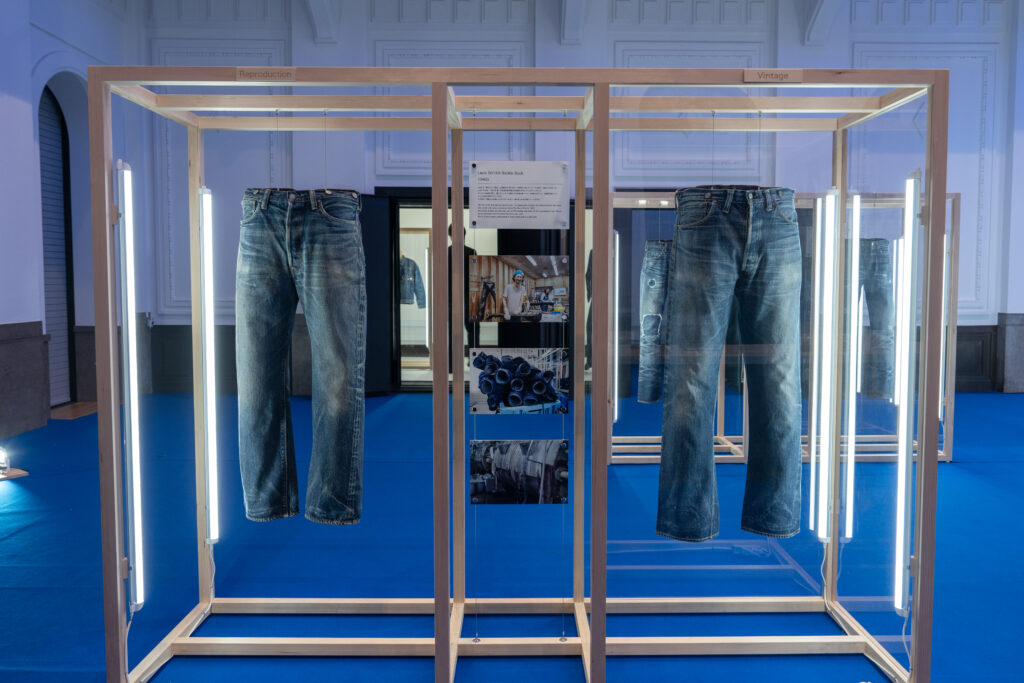
These are Levis 1942 model. It is also called the “Great War model” because it was released about a year before the start of World War II, and its main feature is that it has a belt called a buckle attached to the back of the jeans.

The fabric is thicker than the regular Levis501XX, and the front has a button fly.
There are hidden rivets on the inside of the back pocket, and we can tell from the type of rivets that this is a 1942 model. Vintage denim, whose age can be clearly determined, is highly valued and valuable.
Reproduced denim has also many features such as buckles and hidden rivets that are essential for determining the age, and faithfully reproducing the vintage.
Levis 507XXE size52 /split back(T-Back) 1950s

A jeans jacket with one chest pocket is called a “first,” while a jeans jacket with two chest pockets is called a “second.” Also, the point is the letter “E” at the end of the lot number 07XXE. This means “extra size”, there are only sizes up to 50 in recent catalogs, but when you measure the actual size of this jeans jacket, there are 52. Furthermore, the size is written as 54 on the leather patch, indicating that the size has shrunk as it has been used.
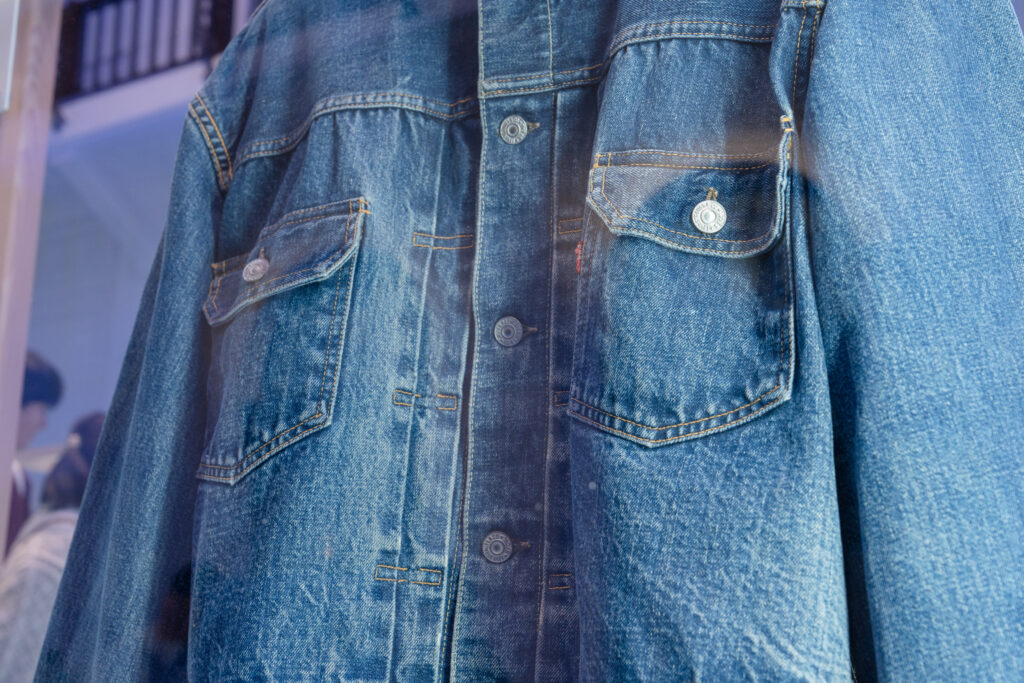
Jeans jackets that are larger than a size 46 will not have enough fabric width, so there will be a vertical seam on the back. In addition, Levi’s jacket has horizontal stitching on the back. I started calling it a “T-back” about 20 years ago because it looks like the letter T when viewed from the back. It is also called a split back in America.
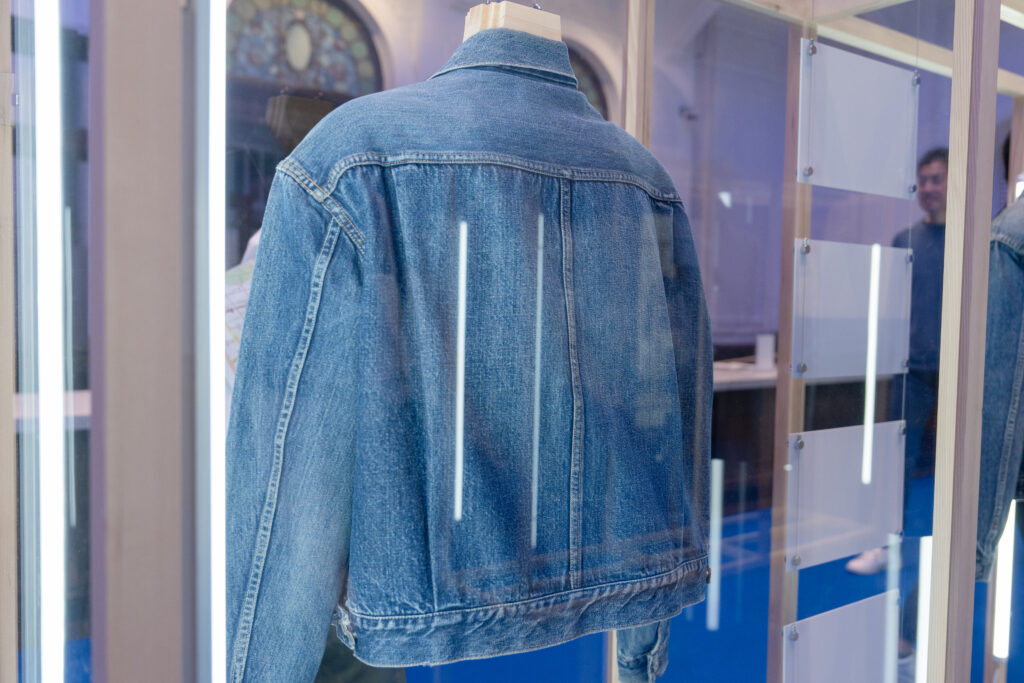
Big size jeans jacket with T-back are really popular and rare. Even though I am usually involved in denim, I have only seen 6 pieces in Japan. In market terms, it would cost around 5 million yen. This product has also been completely reproduced, and the skills are featured in the specifications of the T-back on the back and the reproduction of discoloration on the stitching.
Levis 501 “66”model/1974s
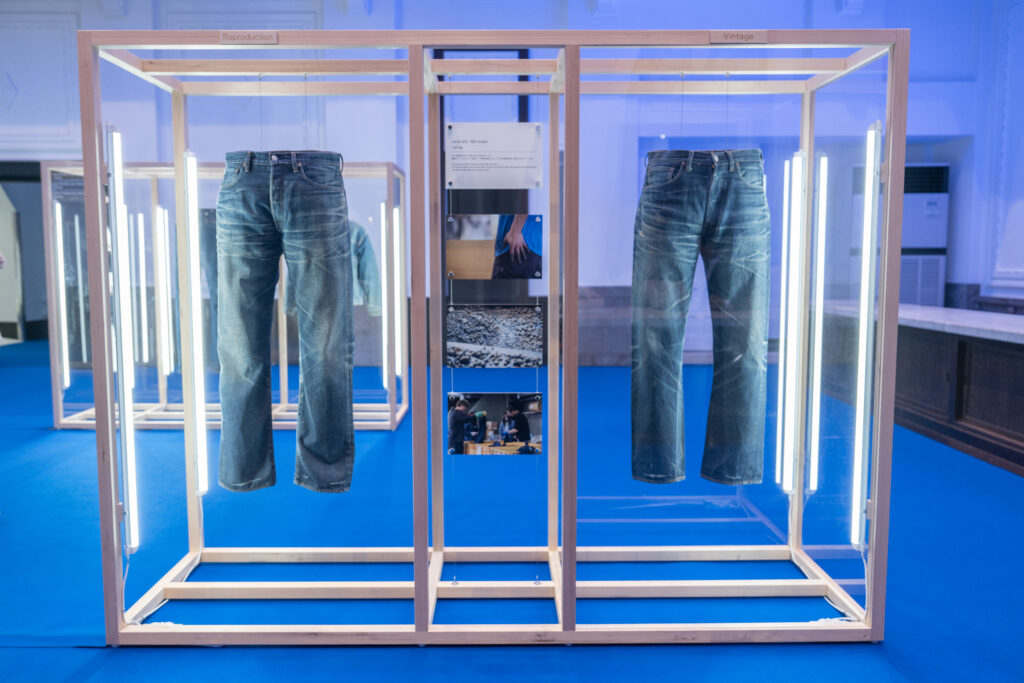
For this exhibition, we want people to feel the charm of vintage denim’s faded colors, so we have provided not just jeans, but also jeans that clearly show the faded color. This is the one I bought dead stock (in new condition) in my size that was perfect for me, took it down on my 40th birthday, and raised it for about 1 year and 7 months.
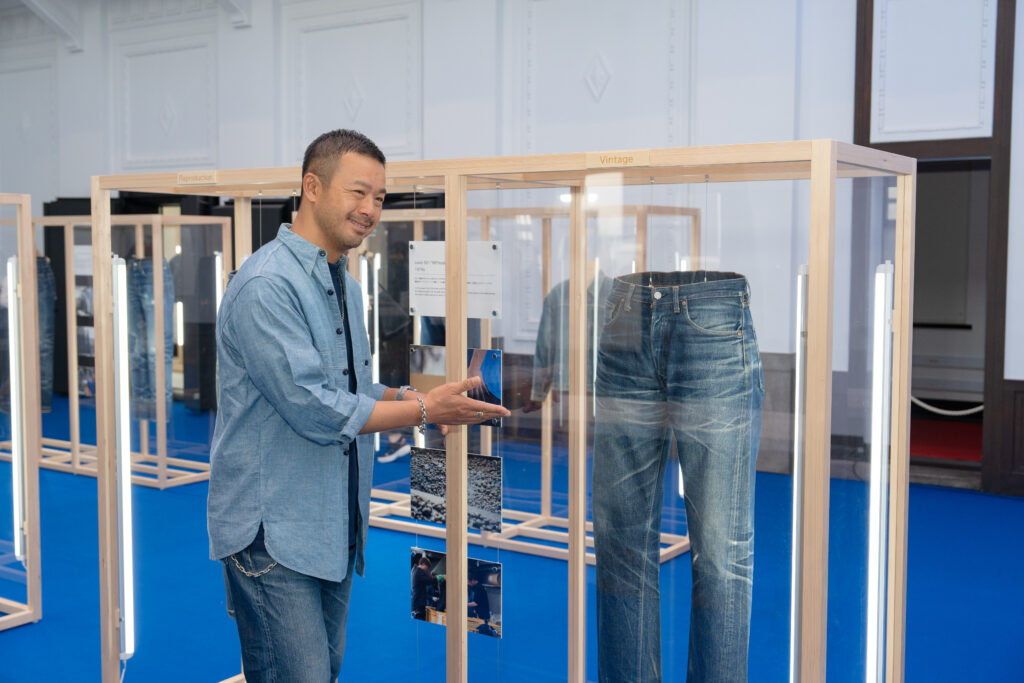
I always wear these jeans when I go shopping in America, and I also went to outdoor events in Thailand. I think the color is perfect with the current state of fading, so I’m wearing it carefully to prevent the color from fading any further. This is the jeans I wear the most and have a lot of feelings for.
Levis 213 /1930s
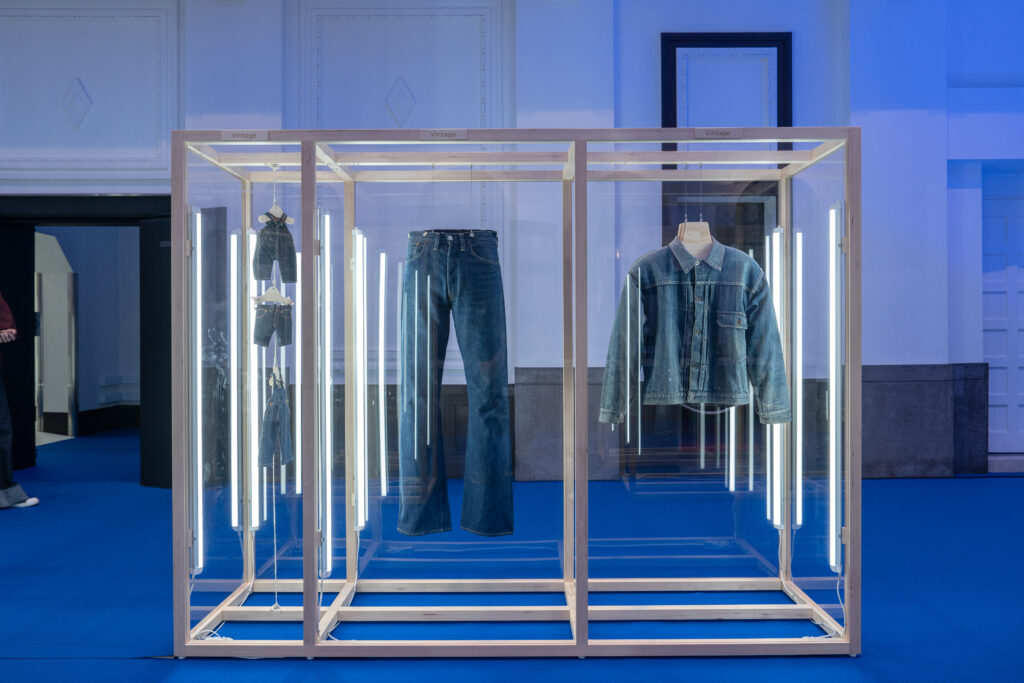
In this exhibition, these are relatively old model from the 1930s. These jeans were purposely made at a reasonable price as a “cheap version” of 506XX. For example, if the 501XX at that time was sold for 9,800 yen, this one would have been sold for about 7,800 yen. However, there is an interesting story behind it: its value increased because it was produced in small numbers.
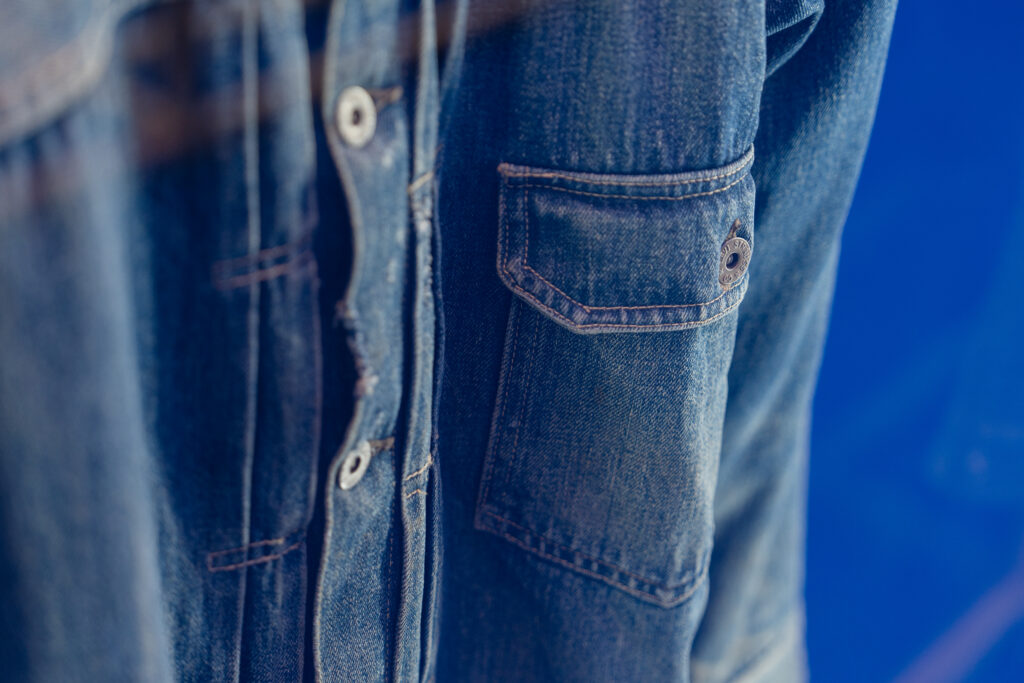
The buttons usually have silver buttons, but the cheaper versions have donut buttons with a hole in the center. The reproduced one features the simple silhouette that is characteristic of workwear, as well as details such as black lacquered donut buttons.
Levis 501XX 1922model

This is the 1922 model of Levis 501. Since this year, it has also been called the “22 model” because it has belt loops. In the past, workers used to hang their jeans with suspenders, which is why the earlier Levis 501 did not have belt loops. I feel that this model is packed with features, such as the suspender buttons and buckle back, and the lack of the Levis signature red tab. These jeans are extremely valuable, including the condition in which they have been stored.
3 small items
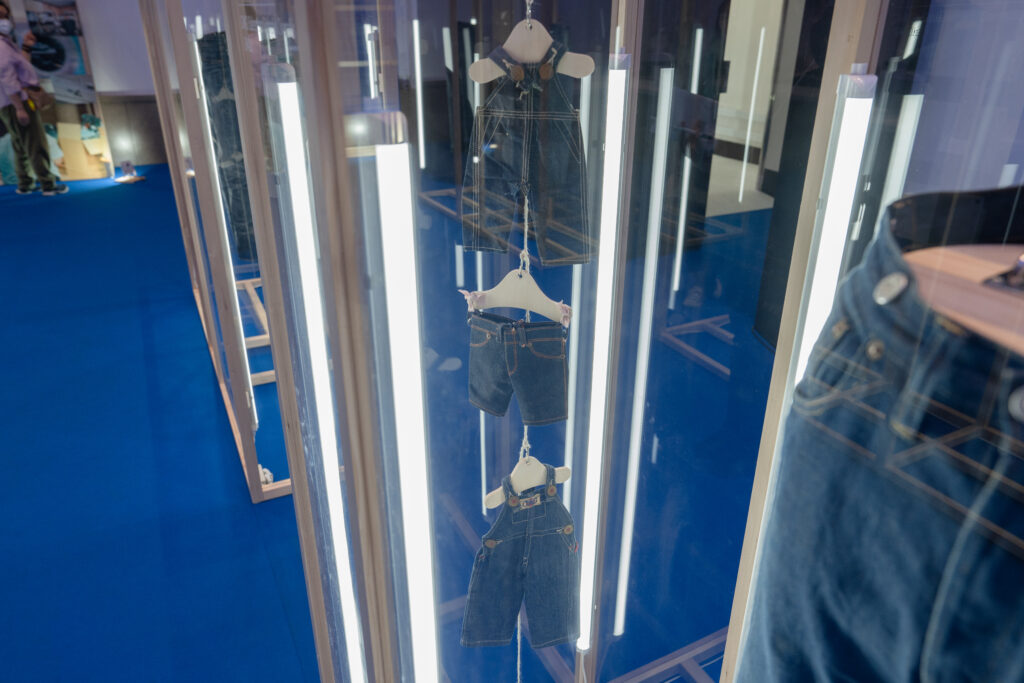
These are overalls and jeans for dolls. In the past, Lee made a doll called “Buddy Lee” for advertising purposes, and it is thought that it is worn in the 1930s. Also, the overalls at the bottom are from a Canadian brand called GWG. It is salesman samples used by employees at the time when conducting sales. Since it is a “sample” rather than a product, it is a rare item that is rarely available on the market.
Levis 501 BigE Style /1967s

The jeans in this exhibition are the ones with the most discoloration. These jeans are an extra-large size called “BigE” among the 501s, and are estimated to be from around 1967. If you look closely, you can see that the whisker on the front is discolored, and there is another discolored whisker below the knee. Normally, this discoloration only appears on the front and the back of the knees, so this discoloration is extremely rare.

My guess is that it was probably worn by fishermen in America. If you wear rubber boots, you may tuck the hem of your jeans, and wear something rubberized, the crumpled parts will probably rub against the boots and rubber, resulting in an artistic fading effect. This denim faithfully reproduced the contrast of shades and characteristic repaired parts that were created by continuing to wear the denim from its rigid state. I guess these jeans were probably the most difficult to reproduce.
Levis 506XXE size46 /split back(T-Back) 1942s
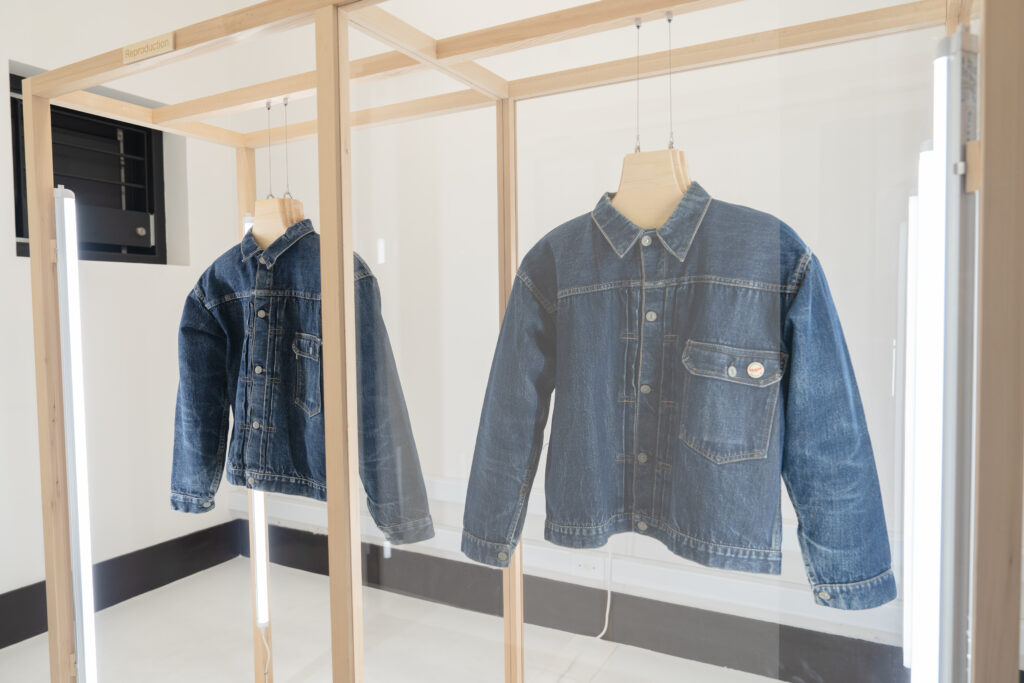
This is a type of jeans jacket with one chest pocket, the so-called “first” model. Lot number 506XXE is marked with an extra size “E”, and the actual size is 46, which is a big size that is currently very popular. Of course, there is a T-shaped split back on the back.
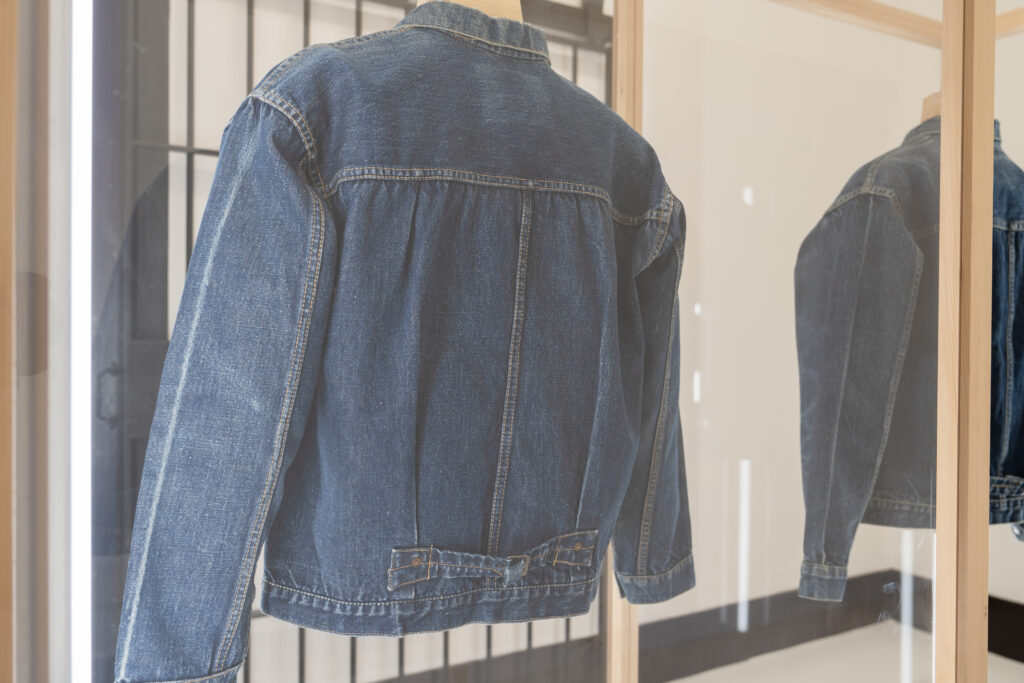
This pair of jeans has the highest price at this exhibition venue, and it is the one that truly makes you feel the true value and future potential of denim. The color fading of the reproducing and the processing of the details are perfect, and at first glance it looks exactly same. I felt that it was a truly artistic finish.
The future of the local denim industry as seen by Mr. Fujiwara
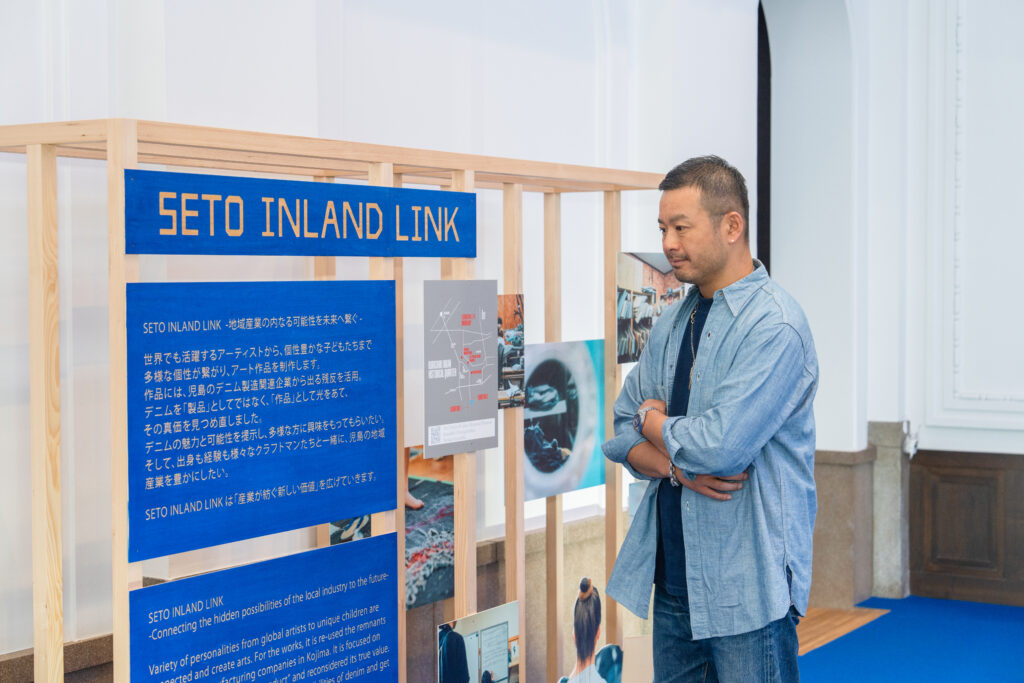
This time, we received a call from Mr. Uneo of YutoRi18 Co., Ltd. to hold a big event called “SETO INLAND LINK”. Our mutual desire to “want to share the appeal of denim” matched, and an exhibition of vintage denim and reproduced denim came true. I hope that many people were able to experience the culture and history of denim.
My personal opinion is that while promoting denim culture, I want to create a denim vocational school. I think it would be great if a vocational school could be built here in Kojima, Kurashiki City, Okayama that would be an opportunity to revitalize local industry.
PROFILE
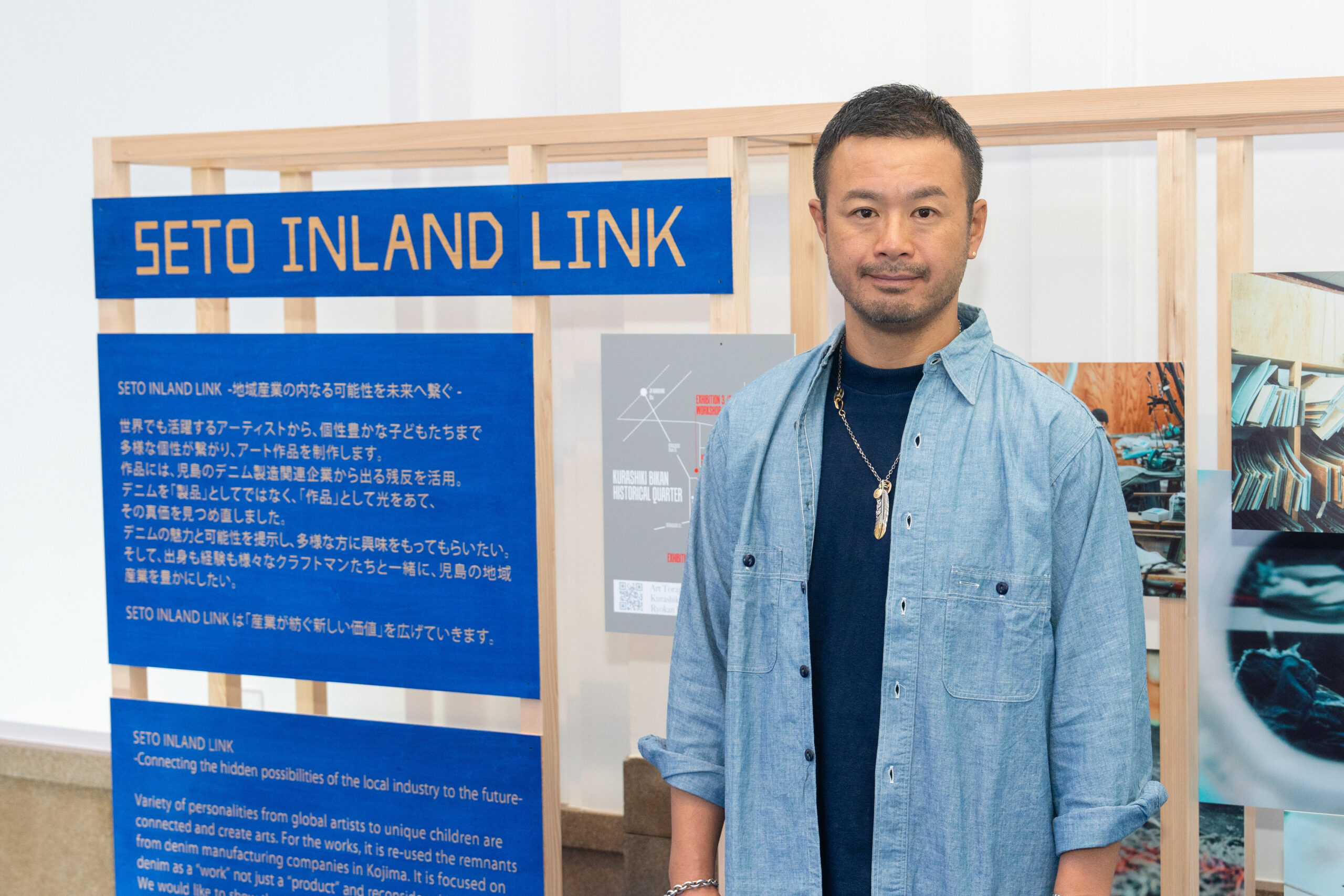
Yutaka Fujihara / A director of BerBerJin
He is a driving force behind the popularity of denim and he made the vintage denim boom.
Born in Kochi Prefecture in 1977. He is s director of the vintage shop BerBerJin in Harajuku, Tokyo. He is also known as Japan’s leading vintage denim advisor and is involved in collaborations with various brands and denim production. His book “Denim as Education” (Published by KADOKAWA) and “BerBerJin Channel” are popular on YouTube.
DESTINATION

The Kurashiki Bikan Historical Quarter
In particular, the area around the Kurashiki River is known as the Kurashiki River Traditional Buildings Preservation District, and is designated as a nationally important traditional building preservation district. There are representative buildings include mansions with white walls and Namako walls, and the Ohara Museum of Art, Japan’s first Western art museum.
